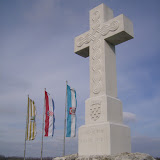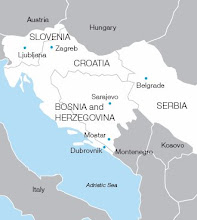Approximately 2,000 people were killed over the course of the siege, 800 disappeared, and 22,000 people displaced (after the fall, Croats were expelled from the city). 261+ people (including 200 patients and staff of the hospital) were taken to neighboring Ovcara, massacred and buried in a mass grave by Serb militias.
The city was peaceful reintegrated (i.e. returned to Croatia) in 1998, with the first Croats returning in 1999. It remains the best example of peaceful transition in history of the UN, in that Vukovar is NOT a ghost town (despite what many of my pictures show) – it is being reconstructed and refugees are returning (current pop = 30,00).
Integration of Schools
However, 18 years later, Vukovar is still not entirely integrated, especially the school system. From kindergarten to graduation, Serb and Croat children are mostly educated separately. Vukovar is not the only town like this – many schools are still segregated. There are separate classes, separate shifts, and sometimes, separate buildings. There are Serb teachers and Croat teachers, and separate history books for each group. The versions of history the children are taught are not the same. This has significant implications for the future of Vukovar.
There are movements towards integrating the children, but it’s a lot of work. Surveys show that kids are the least likely to support integration – they don’t know any better. The teachers are in the middle (half of them would lose their jobs). The parents are most likely to support integration, because they remember an integrated, peaceful, multiethnic community. It’s really interesting – are “good Serbs” and “good Croats” being raised, or are good citizens being raised? It’s important for the future of the city, since Serb students go to Serbia for university (and stay there) and Croat students go to Zagreb or elsewhere for university (and stay there); the “brain drain” needs to be stopped.
Photos
 |
| Vukovar |
I know the city looks like just a bunch of bombed out buildings, and I have to admit, it's hard to get past that. But, it's not a ghost town - there are 30,000 people who live there (Croats were able to return 10 years ago). The most haunting thing was the museum in the bomb shelter of the hospital. It's staged to look like it did during the siege and it is just really eerie. It's still a functioning hospital - I had to walk past actual waiting rooms, patients, nurses, etc. to get down there (I also had to stop to ask three different staff members - I was sure at any minute I was going to be asked to leave!! Nothing like that would ever exist in the States!). The "museum," like the memorial at Ovcara, was really dramatic and left an impression. I had goosebumps the entire time we were in Vukovar and they weren't from the cold...

1 comment:
your right, it does look like a bombed out ghost town... but I imagine most of Europe, especially France, looked like that after WWII and its fine now. it just needs time to rebuild
Post a Comment